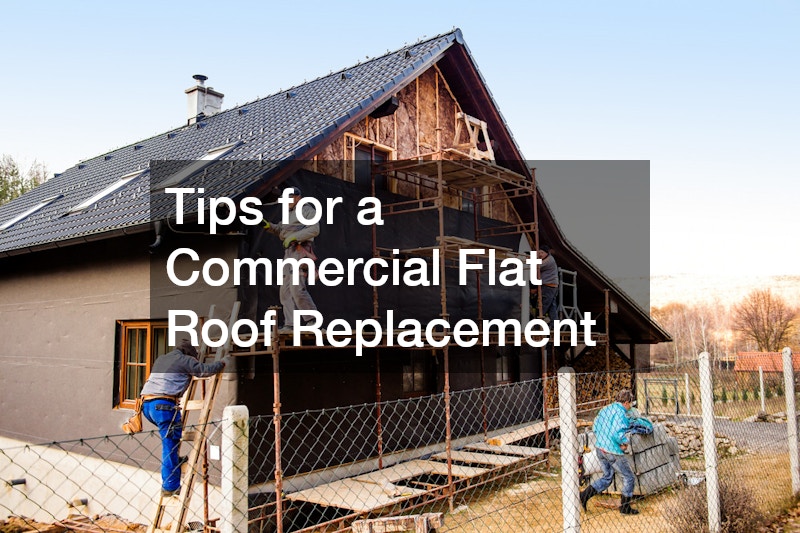Replacing a commercial flat roof is a significant investment that requires careful planning and execution. Not only does it protect the structural integrity of the building, but it also affects energy efficiency and can impact the building’s overall value.
Understanding the Need for Replacement
Before deciding on a commercial flat roof replacement, it’s critical to understand the condition of your existing roof. Often, signs such as persistent leaks, visible damage, or deteriorating materials indicate that repair might not suffice, and a full replacement could be necessary.
By engaging professional inspection services, building owners can assess the extent of damage and make informed decisions regarding a flat roof replacement.
Ignoring the signs of a failing roof can lead to severe consequences, including structural damage and compromised business operations. Addressing these issues promptly with a commercial flat roof replacement can prevent unnecessary expenses and inconveniences. Make sure to weigh the long-term benefits against the upfront costs for a confident decision.
Choosing the Right Materials
Selecting the appropriate materials is crucial for the longevity and efficiency of a commercial flat roof replacement. EPDM, TPO, and PVC are popular choices, each offering unique benefits tailored for different climate conditions and energy efficiency requirements. When choosing materials, consider durability, energy savings, and local climate to ensure the best outcome for your commercial property.
EPDM is known for its resilience in extreme weather, while TPO offers energy efficiency with its reflective surface. PVC, on the other hand, is celebrated for its chemical resistance and durability. Consulting with a roofing expert can help in determining which material is best suited for your specific needs and budget for a flat roof replacement.
In addition to the material, the installation process plays a vital role in the success of a commercial flat roof replacement. Choose certified and experienced contractors to ensure a flawless installation that maximizes the lifespan and functionality of the new roof. A poorly executed installation can negate the benefits of high-quality materials, so invest in professionals who adhere to industry best practices.
Budgeting and Planning
A comprehensive budget is necessary for an effective commercial flat roof replacement. Consider not only the cost of materials and labor but also potential hidden charges such as waste removal and unexpected repairs. Planning for contingencies ensures that you won’t be caught off-guard by any additional expenses during the replacement process.
Investment in a flat roof replacement can be substantial, but it’s important to consider it as a long-term investment in the property’s future. Many building owners find that energy savings, reduced maintenance costs, and boosted property value often offset the initial expenditure. Evaluating all financial aspects in advance positions you for a smoother undertaking.
Timing is another essential factor when planning a commercial flat roof replacement. Ideally, schedule replacements during seasons with mild weather conditions to minimize disruptions and additional weather-related costs. Clear communication with your roofing company regarding timelines and anticipated milestones will facilitate a more seamless transition.
Ensuring Compliance and Safety
Compliance with local building codes and safety regulations is non-negotiable in a commercial flat roof replacement. Failing to adhere can result in fines, halts to the project, or unsafe conditions. Collaborating with contractors who emphasize adherence to these guidelines ensures a safe and regulatory-compliant replacement process.
Safety measures during the replacement process should be a priority to protect workers and building occupants. Implement appropriate precautions and provide necessary training to all personnel involved. Taking these steps can prevent accidents and injuries, avoiding prolonged project timelines and additional costs.
Quality assurance checks throughout the commercial flat roof replacement are indispensable in maintaining compliance and safety. Conduct regular inspections at every stage of the project to verify that safety protocols are observed and performance standards are met. These check-ins yield a successful replacement outcome that’s safe and reliable.
A flat roof replacement is a pivotal undertaking that influences the durability and efficiency of a building. By understanding the need for replacement, choosing the right materials, budgeting effectively, and ensuring compliance and safety, building owners can achieve a successful outcome. Following these tips and prioritizing quality throughout the process maximizes the return on investment and secures the long-term integrity of the commercial property.
Remember, a proactive approach to roof maintenance and replacement is vital in safeguarding the building’s value and performance. Employ knowledgeable professionals and engage with the latest roofing innovations to stay on top of your property needs. By doing so, you’ll ensure that your commercial flat roof replacement is a strategic choice that benefits your business for years to come.

